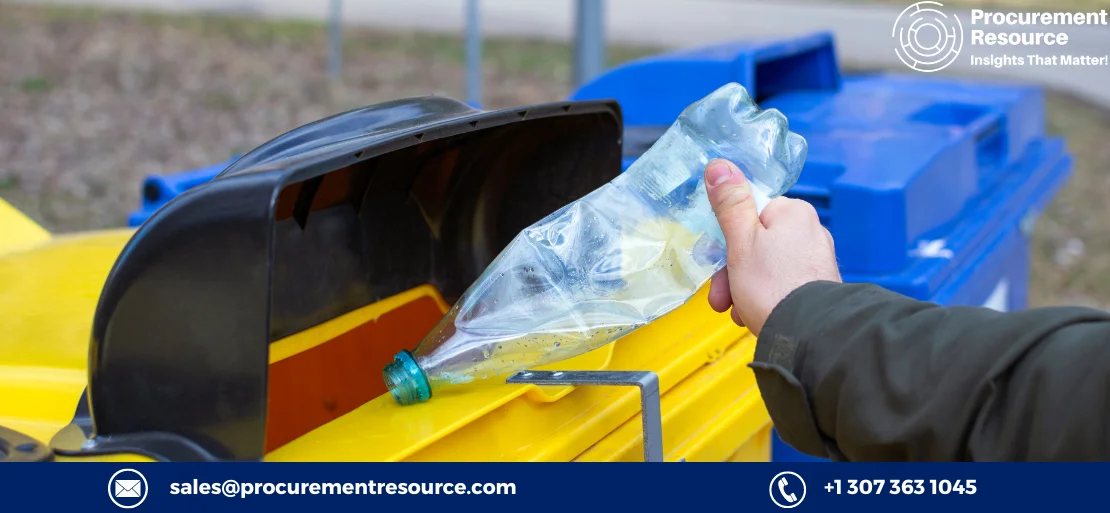The Market Dynamics of PET and its Demand

This blog contains in-depth information on PET definition, market drivers, pricing trends, and regional outlook.
PET: Definition
PET is a thermoplastic polymer that is extensively used in the manufacture of plastic bottles, food containers, and packaging products. It is a robust, lightweight, transparent material that is resistant to moisture and most chemicals, making it suitable for a wide range of applications.
It is also easily recyclable, making it a popular choice for environmentally friendly packaging. It is made by combining ethylene glycol and terephthalic acid or its derivatives. PET is frequently referred to as polyester, however, it is not the same as the fabric of the same name.
It has a relatively high density compared to other thermoplastics, ranging from 1.3 g/cm3 to 1.4 g/cm3. It is a sturdy and long-lasting material, making it ideal for use in packaging applications requiring resistance to wear and tear.
Request Access For Regular Price Update of Polyethylene Terephthalate (PET)
It is a translucent material, making it perfect for use in packaging applications that need product visibility. It has a rather high melting point, around 260°C. As a result, it is appropriate for use in applications requiring heat resistance.
Most compounds, including acids, bases, and alcohols, are resistant to it.
Market Drivers
Owing to its strength, durability, and clarity, PET is frequently employed in the packaging sector. The market for PET is being driven by rising demand for packaged foods, beverages, and other consumer items.
It is a recyclable material that is increasingly being used in the production of sustainable packaging solutions. The increased emphasis on environmental sustainability is fuelling global demand for PET.
It's also used to manufacture polyester fibers, which are utilised in the textile industry to make clothing, upholstery, and other items. The market for PET is being driven by the increased demand for textiles.
New technologies, like blow moulding and injection molding, have made it easier to make PET products in an efficient and cost-effective manner. This has boosted the market availability of PET products, fuelling demand for the material.
As economies expand and consumer purchasing power rises, so does the demand for consumer goods, including PET packaging materials. This is fuelling the global need for PET.
PET Price Trend and Forecast
North America
Excess inventory in the market recently pulled down Polyethylene Terephthalate (PET) prices, while producers decreased operating rates and limited new production.
Nonetheless, there remained significant market uncertainty, which reduced demand and prevented a rebound. Meanwhile, decreased demand from the beverage and bottling industries was the primary contributor to the decline.
As winter approached, PET production cost declined. Despite the fact that no plant shutdowns were identified, DAK Americas and APG Polytech, LLC/FENC industries in the United States continued to operate normally.
APAC
The domestic Polyethylene Terephthalate (PET) Resin pricing was restricted and weak in recent months. The main reason for the drop was a drop in demand from the beverage and bottling industries.
End-user demand was ordinary overall, although small and medium-sized downstream clients largely purchased out of necessity.
Chongqing Ching reduced its operating rate from 1.2 million Mt/year to early October 2022. Later, logistics were slowed due to COVID-related constraints. Furthermore, Jiashan Molai Trade Co., Ltd. and Shanghai Quyi Industry Co., Ltd. also saw an increase in profit margins in the third quarter as a result of delayed manufacturing, low supplies, and covid restrictions.
Europe
PET Resin manufacturers reduced the price of Polyethylene Terephthalate (PET) Bottles by 6 to 9% as feedstock PTA costs fell by 5.2% in recent months.
The weak demand from the packaging industry also contributed to the downward trend. Since the beginning of the winter season, sales of downstream beverages and water bottles have declined, contributing to a decrease in PET bottle offtakes.
While PET bottles were in extremely low demand in the domestic market, European manufacturers recognised the low-cost import material from China.
Regional Outlook
The global Polyethylene Terephthalate (PET) market is expected to grow in the next years, thanks to rising demand from various end-use sectors such as packaging, textiles, and automotive.
Due to rising population, urbanization, and industrialization in countries like China and India, Asia Pacific is the largest market for PET. In addition, the region is a major manufacturer and exporter of PET resins and products.
Read More About Polyethylene Terephthalate (PET) Production Cost Reports - REQUEST FREE SAMPLE COPY IN PDF
North America and Europe are also important markets for PET, owing to increasing demand for packaging materials and a growing emphasis on environmentally friendly packaging solutions. Demand in these regions is also being driven by the rising usage of PET in the automobile industry for the creation of lightweight and durable components.
The expanding demand for PET products in numerous end-use sectors is likely to drive significant growth in Latin America, the Middle East, and Africa in the coming years.
Overall, the worldwide PET market is likely to expand at a moderate rate in the next years, driven by rising demand for sustainable packaging solutions and a greater emphasis on environmental sustainability.
About Author:
|
Prakhar Panchbhaiya Senior Content Writer at Procurement Resource Prakhar Panchbhaiya is an accomplished content writer and market research analyst. With over 4 years of experience in content creation and market analysis encompassing many industries, including pharmaceuticals, nutraceuticals, biochemistry, healthcare, ed-tech, and Food & Agriculture, he has been creating quality content for multiple sectors. He is a Biochemistry major with sturdy backing in a PG diploma in digital marketing, helping in the exhaustive content creation based on extensive research and competitive marketing. |

COMMENTS (0)